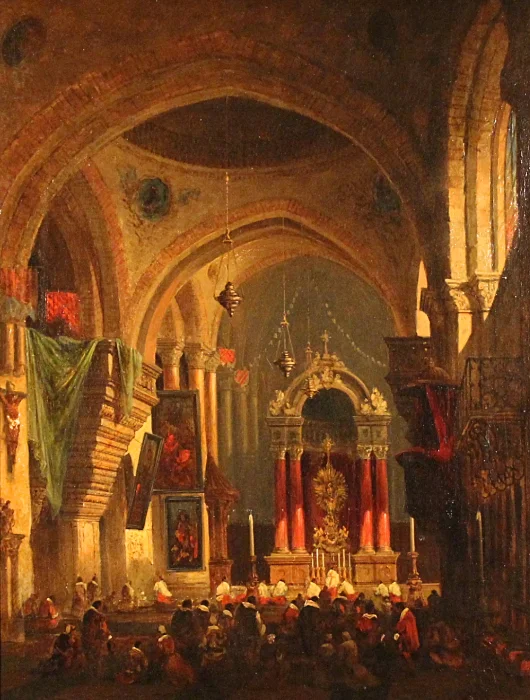Angoulême, France, oil on canvas, c.1859
David Roberts
(Scottish, 1796-1864)
David Roberts was born in Stockbridge on October 24, 1796 into a poor shoemaker’s family. Displaying artistic talent from an early age, Roberts was apprenticed to a house painter at the age of 10. His training lasted seven years, and included painting murals and working in various mediums.
After his apprenticeship ended in 1815, Roberts moved to Perth where he served as foreman on the Scone Palace renovation. He then took a job painting sets and scenery for James Banister’s traveling circus, where he also filled a minor role as a pantomime. With the troupe’s demise in 1817, Roberts worked as a stage designer at the Pantheon Theater in Edinburgh, followed by a reluctant return to house painting. Dreaming of the future, Roberts spent his evenings refining his sketching and painting talents. After a brief return to the reopened Pantheon, Roberts secured a position as principal painter at the Theatre Royal in Glasgow, followed by a stint at the Theatre Royal in Edinburgh.
It was there that Roberts met and was married briefly to Scottish actress Margaret McLachlan in 1820. By the time the marriage ended in 1821, Roberts had become a prolific oil painter and three of his landscapes were accepted into the Fine Arts Institute of Edinburgh. Encouraged by his good friend, artist William Clarkson Stanfield, Roberts also submitted paintings to the 1822 Exhibition of Works by Living Artists.
In 1823, aged 26, he moved permanently to London. The following year, he submitted paintings to the exclusive British Institution and to the newly formed Society of British Artists. During this significant year, Roberts visited Europe for the first time, where he was inspired by the architecture of the castles, cathedrals and monuments. Through commissions and continued work as both a fine artist and stage artist, Roberts established himself as a premiere architectural artist. In 1830 he was elected president of the Society of British Artists.
Traveling to Spain formed a turning point in his career. At the end of 1833, Roberts completed over 200 sketches, of which 25 were lithographed and published. Fascinated with the exotic, he traveled next to Egypt, Syria and Palestine, where he produced a great number of sketches and watercolors. Upon his return to Britain, Roberts worked with lithographer Louis Haghe from 1842 to 1849 to produce two lavishly illustrated series: Sketches in the Holy Land and Syria, 1842–1849 and Egypt & Nubia. His travels to the Palazzo Ducale in Venice, Italy, resulted in a volume of illustrations titled Italy, Classical, Historical and Picturesque (1859). His final production was a series of illustrations of London from Thames. Roberts completed six before his passing on November 25, 1864. In 2016, his painting Jerusalem, from the South sold at auction for GBP 962,500. Many of Roberts’ works are in the permanent collection of National Galleries Scotland.







